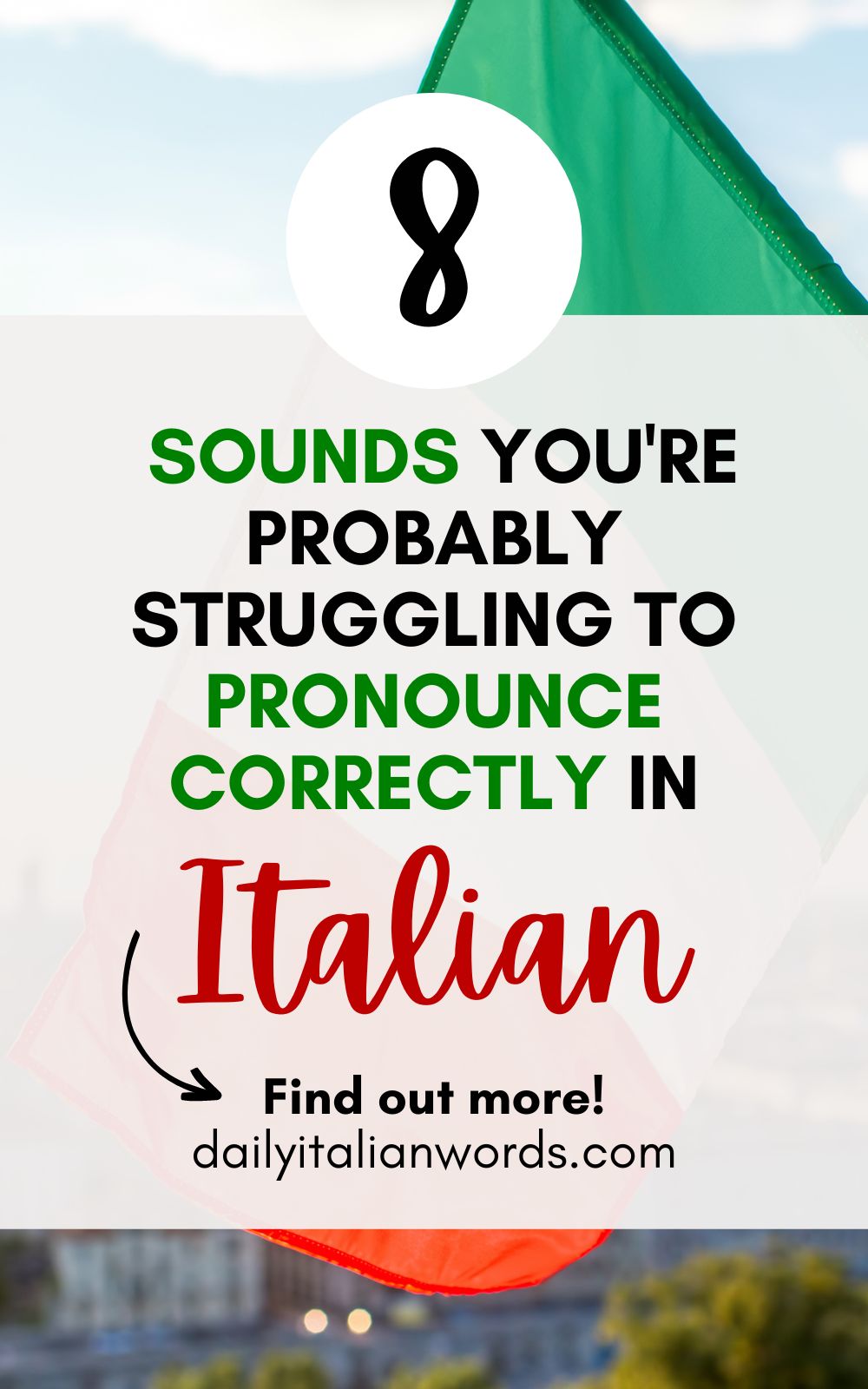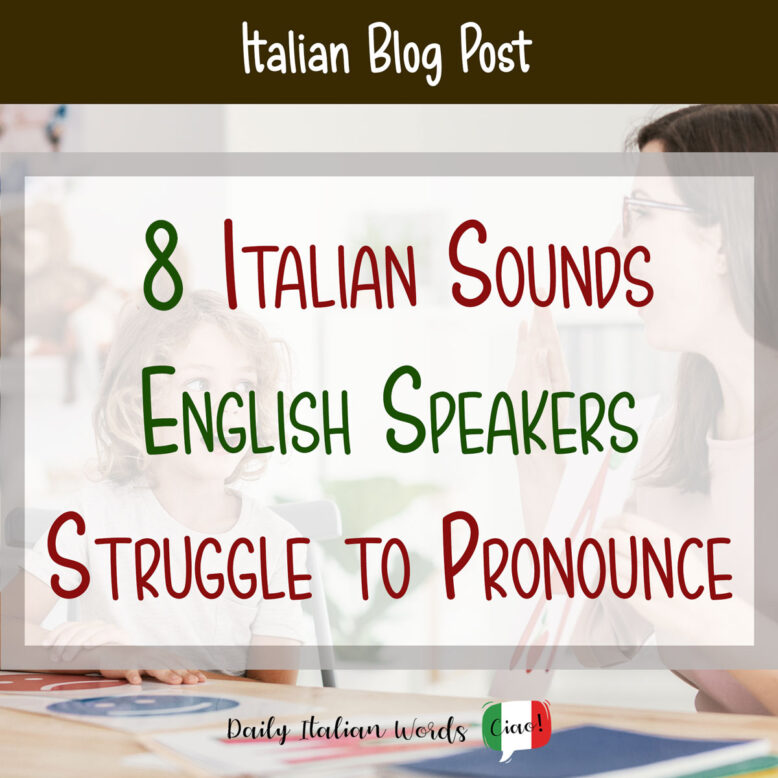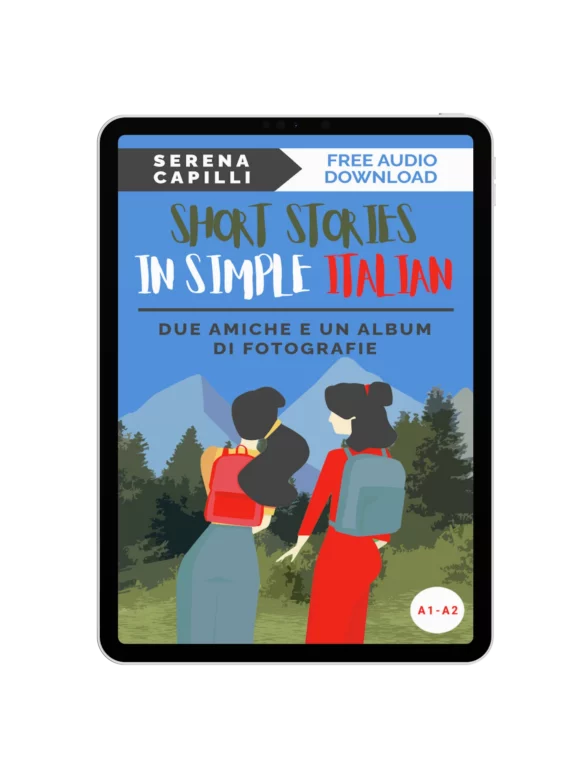All the world’s languages are made up of phonemes, or in other words, unique units of sound that help us distinguish one word from another. A letter in any given alphabet may represent one or more phonemes. For example, the way the English letter A sounds in the word ‘apple’ is completely different to how it sounds in the words ‘bake’ ‘father’ ‘ball’ and ‘many’.
Despite having a very similar alphabet, the Italian language has far fewer phonemes than English: 28 versus 44 to be exact. However, a handful of these Italian phonemes do not exist in English, making them a challenge for us to pronounce when we first start learning the language.
In this article, we take a look at eight Italian sounds English speakers struggle to pronounce correctly, even after years of speaking the language. Let us know which sounds trip you up in the comments below!

1. The letter R
IPA (International Phonetic Alphabet): [r]
Let’s start with the phoneme that defines the Italian language, the alveolar trill, or trilled / rolled R. In English, pronunciation of R has many variations in different dialects, but none of them (except that in Scottish English) correspond to the Italian [r], which consists of a series of vibrations of varying lengths.
In unstressed syllables and the intervocalic position, you may hear just one or two vibrations, whereas in a geminate trill, consisting of two Rs side-by-side, expect to hear three or more. If there is just one vibration, the [r] becomes a tapped [ɾ] sound.
rana
(frog)
stressed syllable (a couple of contacts)
gara
(race)
inter-vocal, unstressed syllable (only one or two contacts, may sound like a tapped [ɾ])
porro
(leek)
germinate trill (three to seven contacts)
In order to produce the Italian R, place your tongue directly behind the upper front teeth, just below the alveolar ridge. With your tongue in a completely flat and relaxed position, allow the air to flow over the centre of the tongue. It is this airflow that allows the tongue to vibrate, so do your best to avoid tensing or curling your tongue.
If you really want to master the trilled R, we suggest watching this helpful video by our friends at My Italian Circle:
2. S + voiced consonant
IPA (International Phonetic Alphabet): [z] + voiced consonant
When the letter S is followed by any one of the following voiced consonants in Italian – B, D, G, L, R, M, N, V – it transforms from an [s] into a [z]. These consonant clusters never appear at the beginning of a word in English, so they can be uncomfortable to pronounce at first.
sbadiglo
(yawn)
sdraiare
(to lie down)
smalto
(varnish)
sradicare
(uproot)
sgridare
(to yell at)
slitta
(sleigh)
snello
(slim)
sveglio
(awake)
3. The letter Z
IPA (International Phonetic Alphabet): [t͡s] or [d͡z]
You would be forgiven for assuming that the letter Z in Italian is pronounced like its English counterpart, but in actual fact, it represents two different phonemes called alveolar fricatives, written as [t͡s] or [d͡z] in IPA. The former sounds like the ts in “bits” whereas the latter sounds like the ds in “heads“.
Unfortunately, there aren’t any clear cut rules about when to use [t͡s] versus [d͡z]. When the first letter is Z, quite often the voiced [d͡z] prevails, but otherwise, the distribution appears to be quite random. The same applies to words with a double Z. For example:
Z words with [d͡z]
zanzara (mosquito)
mezzo (half)
Z words with [t͡s]
grazie (thank you)
pizza (pizza)
4. Open vs Closed E and O
IPA (International Phonetic Alphabet): [ɛ] and [e] / [ɔ] and [o]
The letter E in Italian can be pronounced either as an open E (written as [ɛ] in IPA) or a closed E (written as [e] in IPA). The open E is just a little more open than the English short E, seen in words like bet or met. The closed E isn’t produced as a single vowel in English – it always slides into another vowel (usually an [ɪ]) to create a diphthong as in words like say (written /seɪ/ in IPA) and make (written /meɪk/ in IPA).
The rules that apply to the letter E in Italian also apply to the letter O. Once again, we have two sounds: the open O (written as [ɔ] in IPA), which sounds like the vowel in English words like paw and awe, and the closed O (written as [o] in IPA), which in English almost always slides into an [ʊ] as in the word no (written as /noʊ/ in IPA).
In spoken Italian, an E or O that appears in an unstressed syllable is always closed (e.g. mare, entrare, caro, orecchio). Otherwise, there are very few rules that govern the distribution of the two Es and Os, not to mention that their pronunciation varies from region to region. If you’d like to know more about when to use open and closed E and O, we encourage you to check out our full article about Italian vowels.
Because the closed sounds don’t exist in English as individual phonemes, English speakers have the tendency to transform the pure Italian [e] and [o] into the diphthongs [eɪ] and [oʊ]. Compare the correct pronunciation of the Italian speaker with the incorrect pronunciation of the English speaker below:
Italian speaker:
English speaker:
fase (phase)
elefante (elephant)
mago (wizard)
telefono (telephone)
5. Double consonants (Le consonanti doppie)
Double consonants in Italian are the bane of every learner’s existence, at least at the beginning! In essence, a double consonant is pronounced with a longer sound (or a pause depending on the word) than a single consonant. By doubling a consonant, you can completely change the meaning of a word, and if you aren’t careful, you might make some embarrassing mistakes! Note that all consonants can be doubled in Italian except for the letter H.
Consider the following minimal pairs:
papa (pope)
camino (fireplace)
ano (anus)
note (notes)
pappa (food)
cammino (walk / stroll)
anno (year)
notte (night)
In English, we might use double consonants in writing – take for example the word “swimming” – but we always pronounce them as if there were only one consonant, never two.
6. The Voiceless Stops: [p] [t] and [k]
This is a minimal difference between the two languages, but if you want to make it easy for an Italian person to figure out where you come from, all you have to do is aspirate your [p] [t] and [k] sounds.
What we mean by aspiration is the forceful expulsion of air that occurs when these consonants appear at the beginning of a word or a stressed syllable in English. Listen to the following examples. (Note that [k] represents both the hard letter C and the letter K.)
park
tractor
card
In Italian, these consonants are not aspirated, making them sound almost like their voiced equivalents [b] [d] and [g] to English ears.
parco
trattore
carte
7. GN
IPA (International Phonetic Alphabet): [ɲ]
The GN sound does not exist in English, so it can be struggle to pronounce it correctly at first. It is said that the Italian GN resembles the NY in the word canyon, but this isn’t exactly true. In order to make an authentic [ɲ] sound, the tip of the tongue needs to be in contact with the back of your bottom teeth. Try saying some of these words to practise your pronunciation:
gnocchi
cagnolino
gnomo
agnello
8. GL
IPA (International Phonetic Alphabet): [ʎ]
Here is another sound that doesn’t exist in English. If you want to attempt the GL sound in Italian, try saying the English word million while touching the tip of your tongue to the back of your teeth.
aglio
maglione
gli
egli
Note that GLI isn’t always pronounced in this way. In certain words, such as glicerina (glycerin) and glifo (glyph) for example, it is pronounced as it is spelled: [gli].

Heather Broster is a graduate with honours in linguistics from the University of Western Ontario. She is an aspiring polyglot, proficient in English and Italian, as well as Japanese, Welsh, and French to varying degrees of fluency. Originally from Toronto, Heather has resided in various countries, notably Italy for a period of six years. Her primary focus lies in the fields of language acquisition, education, and bilingual instruction.


